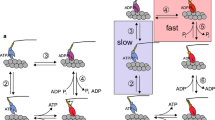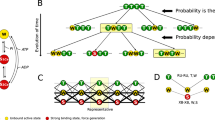Abstract
An increase in ionic strength (IS) lowers Ca2+ activated tension in muscle fibres, however, its molecular mechanism is not well understood. In this study, we used single rabbit psoas fibres to perform sinusoidal analyses. During Ca2+ activation, the effects of ligands (ATP, Pi, and ADP) at IS ranging 150–300 mM were studied on three rate constants to characterize elementary steps of the cross-bridge cycle. The IS effects were studied because a change in IS modifies the inter- and intra-molecular interactions, hence they may shed light on the molecular mechanisms of force generation. Both the ATP binding affinity (K 1) and the ADP binding affinity (K 0) increased to 2–3x, and the Pi binding affinity (K 5) decreased to 1/2, when IS was raised from 150 to 300 mM. The effect on ATP/ADP can be explained by stereospecific and hydrophobic interaction, and the effect on Pi can be explained by the electrostatic interaction with myosin. The increase in IS increased cross-bridge detachment steps (k 2 and k −4), indicating that electrostatic repulsion promotes these steps. However, IS did not affect attachment steps (k −2 and k 4). Consequently, the equilibrium constant of the detachment step (K 2) increased by ~100 %, and the force generation step (K 4) decreased by ~30 %. These effects together diminished the number of force-generating cross-bridges by 11 %. Force/cross-bridge (T 56) decreased by 26 %, which correlates well with a decrease in the Debye length that limits the ionic atmosphere where ionic interactions take place. We conclude that the major effect of IS is a decrease in force/cross-bridge, but a decrease in the number of force generating cross-bridge also takes place. The stiffness during rigor induction did not change with IS, demonstrating that in-series compliance is not much affected by IS.















Similar content being viewed by others
References
Andrews MA, Maughan DW, Nosek TM, Godt RE (1991) Ion-specific and general ionic effects on contraction of skinned fast-twitch skeletal muscle from the rabbit. J Gen Physiol 98(6):1105–1125
Borejdo J, Szczesna-Cordary D, Muthu P, Calander N (2010) Familial hypertrophic cardiomyopathy can be characterized by a specific pattern of orientation fluctuations of actin molecules. Biochemistry 49(25):5269–5277
Candau R, Kawai M (2011) Correlation between cross-bridge kinetics obtained from Trp fluorescence of myofibril suspensions and mechanical studies of single muscle fibers in rabbit psoas. J Muscle Res Cell Motil 32(4–5):315–326
Colombini B, Nocella M, Bagni MA, Griffiths PJ, Cecchi G (2010) Is the cross-bridge stiffness proportional to tension during muscle fiber activation? Biophys J 98(11):2582–2590
Geeves MA, Fedorov R, Manstein DJ (2005) Molecular mechanism of actomyosin-based motility. Cell Mol Life Sci 62(13):1462–1477
Geeves MA, Holmes KC (1999) Structural mechanism of muscle contraction. Annu Rev Biochem 68:687–728
Godt RE, Maughan DW (1988) On the composition of the cytosol of relaxed skeletal muscle of the frog. Am J Physiol 254(5 Pt 1):C591–C604
Gordon AM, Godt RE, Donaldson SK, Harris CE (1973) Tension in skinned frog muscle fibers in solutions of varying ionic strength and neutral salt composition. J Gen Physiol 62(5):550–574
Gulati J, Podolsky RJ (1978) Contraction transients of skinned muscle fibers: effects of calcium and ionic strength. J Gen Physiol 72(5):701–715
Gulati J, Podolsky RJ (1981) Isotonic contraction of skinned muscle fibers on a slow time base: effects of ionic strength and calcium. J Gen Physiol 78(3):233–257
Hanson J, Huxley HE (1957) Quantitative studies on the structure of cross-striated myofibrils. II. Investigations by biochemical techniques. Biochim Biophys Acta 23(2):250–260
Heinl P, Kuhn HJ, Ruegg JC (1974) Tension responses to quick length changes of glycerinated skeletal muscle fibres from the frog and tortoise. J Physiol 237(2):243–258
Highsmith S, Polosukhina K, Eden D (2000) Myosin motor domain lever arm rotation is coupled to ATP hydrolysis. Biochemistry 39(40):12330–12335
Huxley AF (1974) Muscular contraction. J Physiol 243(1):1–43
Iwamoto H (2000) Influence of ionic strength on the actomyosin reaction steps in contracting skeletal muscle fibers. Biophys J 78(6):3138–3149
Kawai M (1982) Correlation between exponential processes and cross-bridge kinetics. Soc Gen Physiol Ser 37:109–130
Kawai M (1986) The role of orthophosphate in crossbridge kinetics in chemically skinned rabbit psoas fibres as detected with sinusoidal and step length alterations. J Muscle Res Cell Motil 7(5):421–434
Kawai M, Brandt PW (1980) Sinusoidal analysis: a high resolution method for correlating biochemical reactions with physiological processes in activated skeletal muscles of rabbit, frog and crayfish. J Muscle Res Cell Motil 1(3):279–303
Kawai M, Halvorson HR (1989) Role of MgATP and MgADP in the cross-bridge kinetics in chemically skinned rabbit psoas fibers. Study of a fast exponential process (C). Biophys J 55(4):595–603
Kawai M, Halvorson HR (1991) Two step mechanism of phosphate release and the mechanism of force generation in chemically skinned fibers of rabbit psoas muscle. Biophys J 59(2):329–342
Kawai M, Zhao Y (1993) Cross-bridge scheme and force per cross-bridge state in skinned rabbit psoas muscle fibers. Biophys J 65(2):638–651
Kawai M, Wray JS, Guth K (1990) Effect of ionic strength on crossbridge kinetics as studied by sinusoidal analysis, ATP hydrolysis rate and X-ray diffraction techniques in chemically skinned rabbit psoas fibres. J Muscle Res Cell Motil 11(5):392–402
Kawai M, Kido T, Vogel M, Fink RH, Ishiwata S (2006) Temperature change does not affect force between regulated actin filaments and heavy meromyosin in single-molecule experiments. J Physiol 574(Pt 3):877–887
Kerrick WG, Kazmierczak K, Xu Y, Wang Y, Szczesna-Cordary D (2009) Malignant familial hypertrophic cardiomyopathy D166 V mutation in the ventricular myosin regulatory light chain causes profound effects in skinned and intact papillary muscle fibers from transgenic mice. FASEB J 23(3):855–865
Lobb RR, Stokes AM, Hill HA, Riordan JF (1975) Arginine as the C-1 phosphate binding site in rabbit muscle aldolase. FEBS Lett 54(1):70–72
Maughan DW, Godt RE (1980) A quantitative analysis of elastic, entropic, electrostatic, and osmotic forces within relaxed skinned muscle fibers. Biophys Struct Mech 7(1):17–40
Mettikolla P, Calander N, Luchowski R, Gryczynski I, Gryczynski Z, Zhao J, Szczesna-Cordary D, Borejdo J (2011) Cross-bridge kinetics in myofibrils containing familial hypertrophic cardiomyopathy R58Q mutation in the regulatory light chain of myosin. J Theor Biol 284(1):71–81
Moore WJ (1962) Physical Chemistry, 3rd edn. Prentice Hall, Englewood Cliffs
Seow CY, Ford LE (1993) High ionic strength and low pH detain activated skinned rabbit skeletal muscle crossbridges in a low force state. J Gen Physiol 101(4):487–511
Sugi H, Abe T, Kobayashi T, Chaen S, Ohnuki Y, Saeki Y, Sugiura S (2013) Enhancement of force generated by individual myosin heads in skinned rabbit psoas muscle fibers at low ionic strength. PLoS One 8(5):e63658
Thames MD, Teichholz LE, Podolsky RJ (1974) Ionic strength and the contraction kinetics of skinned muscle fibers. J Gen Physiol 63(4):509–530
Wang L, Kawai M (2013) A re-interpretation of the rate of tension redevelopment (k(TR)) in active muscle. J Muscle Res Cell Motil 34(5–6):407–415
Wang Y, Xu Y, Kerrick WG, Wang Y, Guzman G, Diaz-Perez Z, Szczesna-Cordary D (2006) Prolonged Ca2+ and force transients in myosin RLC transgenic mouse fibers expressing malignant and benign FHC mutations. J Mol Biol 361(2):286–299
Wang L, Muthu P, Szczesna-Cordary D, Kawai M (2013) Diversity and similarity of motor function and cross-bridge kinetics in papillary muscles of transgenic mice carrying myosin regulatory light chain mutations D166 V and R58Q. J Mol Cell Cardiol 62:153–163
Wang L, Ji X, Sadayappan S, Kawai M (2014) Phosphorylation of cMyBP-C affects contractile mechanisms in a site-specific manner. Biophys J 106(5):1112–1122
Yan Q, Sun Y, Lin J (1996) A quantitative study on the effect of breathing exercises in improving respiratory muscle contration. Zhonghua nei ke za zhi 35(4):235–238
Yount RG, Lawson D, Rayment I (1995) Is myosin a “back door” enzyme? Biophys J 68(4 Suppl):44S–47S; discussion 47S–49S
Zhao Y, Kawai M (1994) Kinetic and thermodynamic studies of the cross-bridge cycle in rabbit psoas muscle fibers. Biophys J 67(4):1655–1668
Zhao Y, Kawai M (1996) Inotropic agent EMD-53998 weakens nucleotide and phosphate binding to cross bridges in porcine myocardium. Am J Physiol 271(4 Pt 2):H1394–H1406
Acknowledgments
This work was supported by grants from the National Institutes of Health HL070041 (MK), and The American Heart Association 13GRNT16810043 (MK). This study was carried out during Dr. Anzel Bahadir’s visit to The University of Iowa with a scholarship (82444403-299-1926) funded by Higher Educational Council of Turkey. The content is solely the responsibility of the authors and does not necessarily reflect the official views of the funding organizations.
Conflict of interest
The authors have no conflicts of interests.
Author information
Authors and Affiliations
Corresponding author
Rights and permissions
About this article
Cite this article
Wang, L., Bahadir, A. & Kawai, M. High ionic strength depresses muscle contractility by decreasing both force per cross-bridge and the number of strongly attached cross-bridges. J Muscle Res Cell Motil 36, 227–241 (2015). https://doi.org/10.1007/s10974-015-9412-6
Received:
Accepted:
Published:
Issue Date:
DOI: https://doi.org/10.1007/s10974-015-9412-6




